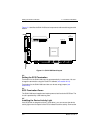
2 – Hardware Installation Installation Help
BC8151101-00 C 2-5
See the Software Installation Guide for the QLA12160 Board on the QLogic web
site http://www.qlogic.com/ for detailed instructions on how to install the QLA12160
board’s software drivers.
If the information displayed on your monitor is not correct and you have checked
the QLA12160 board’s configuration, see section 3 for troubleshooting information.
2.7
Installation Help
If your system has an IDE fixed disk device, be sure to program the system BIOS
to point to the appropriate boot drive. If your system does not have an IDE disk
device, the first bootable SCSI disk device configured (the one with the lowest SCSI
ID) is assigned device number 80 and is the boot device.
For a motherboard BIOS that does not support SCSI disk booting, you can use
settings in Fast!UTIL to select the system’s boot device attached to the QLA12160
board. If the boot device is a CD-ROM, see the CDROM boot setting in table A-1.
If the boot device is a disk, see section A.2.5 about selectable boot settings.
SCSI ID numbers must be unique; otherwise, the BIOS list of SCSI devices
displayed on your monitor is not correct. For example, if you give one of your devices
the same SCSI ID as the QLA12160 board, that device is listed for all SCSI IDs; or
if you have two devices with the same SCSI ID, only one of the devices is listed. If
the BIOS list is not correct, power down the computer and check the configuration.
Be sure to check the QLA12160 board, which uses SCSI ID 7. If you do not see
your device listed on the BIOS listing, see section 3.
If you do not have an IDE drive, set the motherboard BIOS parameters to None or
Not Installed. The ROM BIOS on the SCSI controller automatically configures the
SCSI peripherals.
If the QLA12160 board is on a SCSI bus with any single-ended peripheral device,
for example, a CD-ROM, the QLA12160 board automatically operates as a
single-ended, Ultra device. Consequently, all single-ended device restrictions apply
to the QLA12160 board, even though it is an LVD device (see table 3-1 and
appendix C).


















